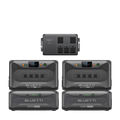Your cart is empty
Shop our productsStorage devices with a capacity rating of at least 3 kilowatt-hours are eligible for the Federal Solar Tax Credit from January 1, 2024. BLUETTI AC300&B300, AC500&B300S, and EP500 series can receive a 30% tax credit.
Adding a solar power system to your home is an important investment. In the long run, home solar power systems can save large amounts of money. What’s more, there are several rebates and tax credits available to help you obtain constant energy. So you’ll get an income tax credit that actually lowers your tax bill.

What is the Federal Solar Tax Credit?
The federal solar tax credit, also called the solar investment tax credit (ITC), applies to the cost of solar systems installed by homeowners for their primary residences in the United States. The ITC can provide 30% tax credit for systems installed in tax years 2022 through 2032.
Solar systems installed in 2020 and 2021 are eligible for a 26% tax credit. In August 2022, The federal solar tax credit is increased to 30% and is extended through 2032. It will decrease to 26% for systems installed in 2033 and to 22% for systems installed in 2034. There is no maximum amount that can be claimed.
What Does the Federal Solar Tax Credit Cover?
The federal tax credit covers 30% of the following:
- Costs of solar panels or PV cells (used to power an attic fan,but not the fan itself)
- Costs of balance-of-system, such as inverters, switches, wiringand mounting hardware
- Laborcosts for onsite preparation and solar panel installation, including permitting fees, inspection costs, and developer fees
- Costs of solar power storage equipmentlike solar batteries. Energy storage devices that have a capacity rating of at least 3 kilowatt-hours (kWh).
- Sales taxes paid for eligible expenses
Federal Solar Tax Credit Eligibility
You might qualify for the ITC if you meet the following criteria:
- Yoursolar system is new or being used for the first time.
- Your solarsystem is installed between January 1, 2017, and December 31, 2034.
- You own the solar system outright (i.e., you purchased it with cash or through financing but you do notlease the system)
- Your solarsystem is located at your primary or secondary U.S. residence or for an off-site community solar project.
For more details, please visit the U.S. Department of Energy or consult your tax advisor.
How to Claim the Federal Solar Tax Credit?
Residential solar energy investors claim this tax credit under Section 25D, while commercial solar investors claim it under Section 48. Individuals claim the residential tax credit on their personal income taxes, while businesses that claim the credit do so on their business taxes.
Here is the basic process of filing for the federal solar tax credit, but it is recommended that you seek professional tax advice to make sure you’re not missing anything. Please note that you can only claim the tax credit once after your solar power installation.
You will need four IRS tax forms (plus their instructions) to file for your solar panel tax credit:
Form 1040 (standard federal income tax form)
Schedule 3 (Form 1040)
Form 5695 (Residential Energy Credit form)
Form 5695 Instructions (Residential Energy Efficient Property Credit Limit Worksheet)
Quick Tip: The Schedule 3 (Form 1040) and Form 1040 are separate forms.
Instructions on filling out IRS Form 5695:
In Part I, calculate the credit of the tax form.
File your solar system as “qualified solar electric property costs”.
On line 1, enter the total costs of solar installation as written in your solar contract.
On lines 6a and 6b, complete the calculations.
On line 14, calculate your tax liability using the IRS’s Residential Energy Efficient Property Credit Limit Worksheet.
On lines 15 and 16, complete the calculations.
You can also carry over any unused amount remaining on your tax credit that you could not claim in a single tax year.
Shop products from this article
Be the First to Know
You May Also Like

What Does a 30% Federal Solar Tax Credit Mean and How to Apply?
Governments around the world are offering programs that encourage homeowners to switch to solar energy. Among the most notable programs is the 30% Federal Solar Tax Credit. It reduces your...

Deadly Flooding Devastates U.S. South and Midwest — What You Need to Know

















































































































































































































































